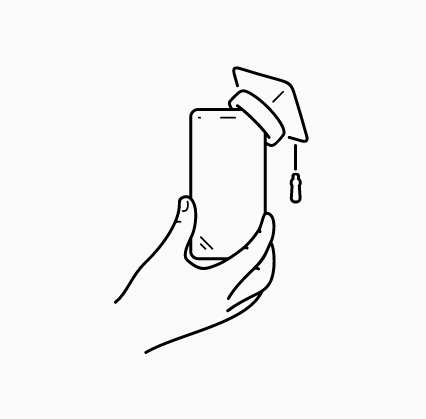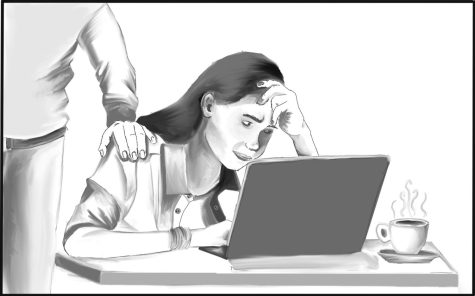Educators Consider the Pros and Cons of Cell Phones in the Classroom

Oleksandr Panasovskyi, UA via thenounproject
“There is this push for more and more technology in the classroom, too,” English teacher Josh Davis said regarding electronics in school. “More and more apps, more and more test prep and different online programs that are supposed to supplement education.”
As cell phones have become increasingly omnipresent and powerful, schools, including BHS, must try to strike a balance between what is useful and what is disruptive as far as electronics are concerned.
“The district is very concerned about students using electronic devices to take pictures, videotape or to record school employees or other students without their consent,” states the BHS Student Handbook of 2019-2020. However, the policy does not ban the use of cell phones for educational purposes.
“Any policy you have in the handbook, there has to be a common sense approach in implementing it,” Principal Paul Chase said.
Chase acknowledges that phones can be used for educational purposes. He also explained that while unsolicited recording of a staff member or student is rather uncommon, it is a serious violation of school rules.
According to Chase, the cell phone policy has evolved since he first came to Beachwood as high school Assistant Principal in 2006. Previous policies regarding cell phones initially restricted the electronic devices to lockers. Later, students were allowed to bring their phones into the classroom, provided that they were set on silent and stayed in the students’ pockets.
Finally, some teachers permitted phones in the classroom, as long as they were not disruptive to the learning process. In fact, several teachers, seeing the potential in handheld devices, use them as instructional tools.
Some high schools in Ohio have stricter policies towards cell phones. The Dayton Daily News published an article in August by Sarah Hagan and Jeremy Kelly examining school policies in the Dayton area.
“Carroll High School officials said students are not allowed to use cellphones during school hours at all, while Dayton Public Schools and the Warren County Career Center said phones must be put away completely during class,” they wrote
It was not specified whether or not school officials in these districts were specifically concerned about prohibited recordings, but clearly, this is a concern of Beachwood staff.
“It’s definitely a potential hazard,” said guidance counselor Jason Downey said. “That’s why we strongly encourage students to not use them in class unless the teacher gives them permission.”
On the other hand, electronic aids can certainly be helpful in a classroom setting, provided that they don’t draw attention away from learning.
“There is this push for more and more technology in the classroom, too,” English teacher Josh Davis said regarding electronics in school. “More and more apps, more and more test prep and different online programs that are supposed to supplement education.”
He also mentioned that he does not see much use in confiscating phones, since students can simply open up their Chromebooks and continue to do non-classwork activities there. Of course, both cell phones and Chromebooks can have content blocked or monitored while on the school wifi.
Science teacher Lisa Bugenske allows students to use their phones to access academic apps or use them as calculators, as well as taking photos to create videos for the class.
Similarly, high school teacher Curtis White, writing for the magazine Education Week, emphasized that students’ cell phones can be used to enhance education.
“My high school students’ use of technology has become almost invisible as we leverage the tools in our pockets to create, collaborate, analyze and synthesize together,” he wrote.
In one BHS study hall, most students were observed working on schoolwork at the beginning of the period, but by the end of the period most were on their phones, texting their friends or watching videos.
This pattern can perhaps be attributed to most students having finished their most pressing work by the end of the study hall. Additionally, while walking the BHS hallways, one observes many students on their phones.
“I’ve had to correct students many times, walking with their head down, texting or looking at Facebook, when they almost run into somebody else or the wall,” Downey said.
When a student is seated and working on an assignment, their cell phone can make for an effective personal music player.
“I usually use it for music. Just now I was doing math homework and I was listening to music,” said Mallory Chylla when asked about her use of her cell phone. “Sometimes, if I finish all my work, I’ll go on social media, but I try to do my work first.”
Communication between students is also made easier by the use of cell phones.
“Sometimes I get a meeting for a club, and they didn’t even tell me the day before,” sophomore Hiba Ali said.
Such last-minute notifications require near-instant communication to rearrange schedules, which is provided by cell phones.
Many teachers have a rack for holding phones in their classroom, where students should leave their devices when not using them for classwork.
While some teachers who do not use the racks have expressed concern about phones being stolen from these racks, Bugenske feels that the use of these racks has actually reduced incidents.
Prior to using a phone holder in her classroom, she would see students pranking one another by hiding their phones, which were grabbed from desktops. Since the phone rack was installed, she has not seen this sort of harassment continue.
Of course, holding another student’s cell phone hostage is far from the only way technology can lead to disruptions in classrooms.
“Harassment, intimidation or bullying also means cyberbullying through electronically transmitted acts,” the Student Handbook states.
Attorney Monica Steiner, a member of the California State Bar addressed these issues in an article on the website CriminalDefenseLawyer.
“In 2014, and after a series of cyberbullying-related teen suicides, a significant public outcry in Ohio arose to modify existing state laws (or create new ones) that better respond to the unique harm caused by cyberbullying,” she wrote.
New legislation has yet to be written regarding cyberbullying, but school boards in Ohio are required by law to adopt strict anti-bullying policies.
“[A bully] may also face charges under Ohio’s ‘menacing by stalking’ law when the bully engaged in two or more acts that caused the victim to believe that the bully was going to cause physical or mental harm to the victim,” Steiner wrote.
“It can take place on any media, sadly,” Ali said. “It happened to my friend.”
She also pointed out that cyberbullying is not limited to cell phones, and can also be committed using Chromebooks.
“When it happens outside the school, it’s hard for us to control,” Downey said. “We really try to support the student and encourage them to stay off social media.”

Roberto DeMarchi began writing for the Beachcomber in 2019. He covers various issues affecting Beachwood students. In addition to writing for the Beachcomber,...













